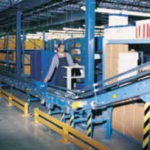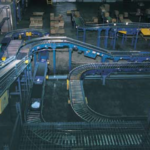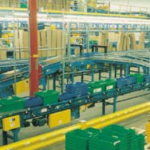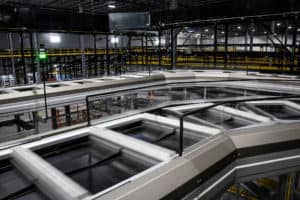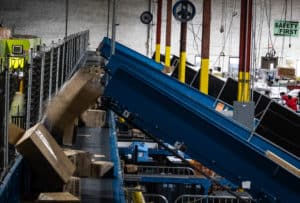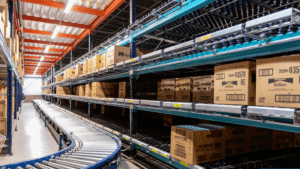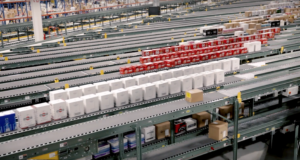
Background
Before the implementation of the conveyor system, H. D. Smith had only two separate pick lines, one for over-the-counter products and one for prescription products. The total conveyor system then was only about 100 feet of powered conveyor and 300 feet of gravity. In implementing the new conveyor system, the company’s main objectives were to increase primary pick locations from 15,000 to 30,000, increase worker productivity, and shorten cycle time.
Automation Integration
RECEIVING: All receiving is done at the north end of the building. The product is received and brought by pallet to the receiving stations and scanned into the system. Products are removed from every carton and placed into a barcoded tote. All corrugate is deposited into an overhead trash conveyor (Hytrol Model TH) which carries it to an automatic baler located outside the building. The product is then married to the tote. The mainframe computer communicates with the conveyor control system (CCS) and tells the CCS which zone to send the tote. The totes are then conveyed across the building to the pick module, sorted to the correct zone, and placed into the correct pick location.
PICKING: Orders are printed in waves at the order induction station. Each order has its barcode denoting an order identification number. The pick sheet is then married to a barcoded (license plate) pick tote. The host system then communicates to the CCS which pick zone or zones the tote must be sent. The tote is then routed only to the required pick zone(s).
CHECKING: Once an order is complete, the tote is conveyed to the checking area. The checkers remove the tote from the Hytrol zero-pressure accumulating conveyor (Model 190-ABEZ) and scan the pick ticket. Each item is then scanned and placed into a shipping tote. When the order has been confirmed complete and correct, a lid is placed on the tote. The tote is then placed onto the conveyor and moved to the shipping sortation conveyor (Hytrol Model SC). The computer communicates the license plate and its assigned sortation lane to the CCS.
SHIPPING: The totes are conveyed to and through an automatic strapper. The strapped totes are then inducted into the sortation system, the license plate is scanned, the appropriate sortation line determined, and the tote is sorted out.
EMPTY REPLENISHMENT TOTES: Once the replenishment totes are empty, they are placed on the line with the pick totes. On each pick level, there is a divert location where the empty replenishment totes are diverted off and conveyed back to the receiving station to be reused.
Outcome
Before the installation of this system, the average lines shipped per DC worker was 40 per hour. With the new system, the average is currently 104 lines per hour. Pickers are picking 250-300 lines per hour. Checkers are checking 350-400 lines per hour. In the past year, the volume has increased by 50%.



